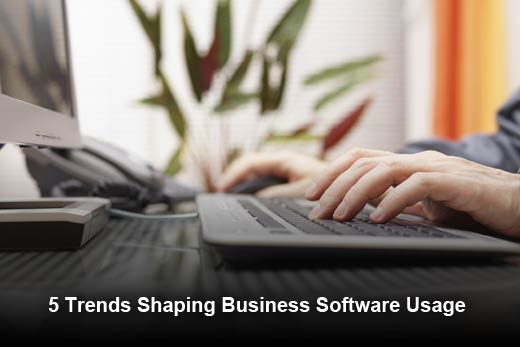In the past decade, business software usage has evolved in a number of ways to meet the changing needs of organizations in the digital age. From how software is delivered to how it is installed and used, the concept of business software is being transformed by a number of cultural and technological developments that are ultimately leading to a shift in mindset: Instead of building software for management usage, it is increasingly being built with a primary focus on the end user.
In this slideshow, Marko Kovac, CEO and founder of Repsly, a B2B SaaS field-activity management company, will highlight the top trends and cultural shifts that stand out as being the driving force behind this change, including software delivery, the mobile boom, social media and Big Data, all of which have ultimately created a consumerization of business software.
5 Trends Shaping Business Software Usage
Click through for the top trends that are driving the evolution and consumerization of business software, as identified by Marko Kovac, CEO and found of Repsly.
Delivery of Software to Users
Technology advancements are one of the foremost ways in which business software has evolved in recent years. Gone are the days of time-consuming disk drive installations or cumbersome site downloads. Today businesses and individuals alike can utilize the cloud to access software in a fast, more efficient manner. And according to the numbers, the cloud is a larger source than ever when it comes to how businesses leverage business software – a recent report from RightScale found that 93 percent of organizations are running applications or experimenting with infrastructure as a service today.
The Mobile Boom
In an age where nearly two-thirds of Americans have cellphones – up from 35 percent just four years ago – the rise of mobile is another trend driving the evolution of business software. In 2014, mobile Internet usage surpassed PC access causing the biggest shift since the dawn of the Internet. Business software needs to think mobile by introducing applications and programs that meet the on-the-go nature of today’s workforce and allow employees to stay connected from anywhere.
Impact of Social Media
The dawn of social media sites, such as Facebook and Twitter, in the mid-to-late 2000s also played a major role in shaping business software by ushering in a new era of communication. The Internet was now for everyone, and real-time communication and sharing became not only an accepted, but expected, part of our culture. In fact, today 74 percent of all adults use Facebook, with an even higher percentage (89 percent) of millennials having a profile on the social networking site. This need for real-time communication also extends into the business world, with organizations wanting business solutions that ease communication and visibility across every level of a company.
Big Data and Predictive Analytics
Thanks to advances in technology, more than 1,020TB of data is being created every second, and companies have more information than ever for making informed business decisions. This exponential rise in available information has also presented a need and an opportunity for business solutions to both leverage data insights to improve their own offerings and position themselves to help organizations increase efficiency and data management.
Consumerization of Business Software
The convergence of the four trends listed previously has driven the final and most important element that is shaping software usage today: the consumerization of business software, meaning a fundamental change in the way business software is presented to end users. Traditionally, software was complex and built based on usage by management, while user experience was seen as a secondary consideration. Software vendors built their own standards, and nobody knew how to use the solutions they created without extensive training, meaning that successful implementation of such solutions took months or sometimes years, depending on the size of an organization.
Today, most employees – especially the millennial generation – are literate in utilizing smartphones and apps, from calendars and social media sites, to organizational tools and on-demand services. When they install a new app on their phone, it doesn’t take long for them to figure out how to use it, and they rarely need to be trained. If business solutions are built with the same principles and features, extensive training and lengthy installation training processes are no longer necessary. In comparison to a yearlong implementation and the opportunity costs tied with that, it feels like comparing a rocket ship with a horse and buggy.








